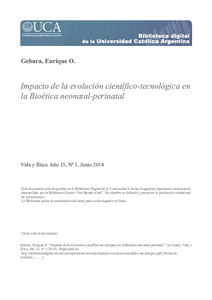Por favor, use este identificador para citar o enlazar este ítem:
https://repositorio.uca.edu.ar/handle/123456789/1474| Título: | Impacto de la evolución científico-tecnológica en la Bioética neonatal-perinatal | Autor: | Gebara, Enrique O. | Palabras clave: | BIOETICA; NEONATOLOGIA; PREMATURO; PESO AL NACER; MORTALIDAD NEONATAL; ETICA | Fecha de publicación: | 2014 | Editorial: | EDUCA | Cita: | Gebara, Enrique O. “Impacto de la evolución científico-tecnológica en la Bioética neonatal-perinatal ” [en línea]. Vida y Ética, año 15, nº 1 (2014). Disponible en: https://repositorio.uca.edu.ar/handle/123456789/1474 | Resumen: | Resumen: Los avances científico-tecnológicos en neonatología en los últimos 40 años han permitido una importante mejoría en la sobrevida de recién nacidos de extremo bajo peso al nacer, sin embargo la mortalidad neonatal aun representa un porcentaje muy grande de la mortalidad infantil. Esto esta principalmente relacionado a las muertes por prematuridad y sus complicaciones, anomalías congénitas y asfixia perinatal. La mayoría de los recién nacidos son tratados favorablemente en sala de partos y son admitidos a la Unidad de Cuidados Intensivos Neonatales (UCIN). La incertidumbre en el pronóstico de los prematuros extremos en el límite de la viabilidad con alto riesgo de morir en la UCIN o presentar alguna discapacidad, presenta un difícil dilema ético. Se deberá considerar cada caso en forma individual y evaluar el riesgo-beneficio entre las conductas a seguir y el “mejor interés para el niño” y los deseos de los padres que guiarán a decisiones éticas. Diferentes guías de cuidado y variaciones en la práctica médica en los límites de la viabilidad fetal se han descripto dentro y entre países. El objetivo es proveer a los padres una comunicación abierta, directa y transparente con suficiente entendimiento de los factores más relevantes en relación a la situación clínica, el pronóstico y las opciones de tratamiento para que ellos puedan tener una significativa participación en la toma de decisiones. Aceptar que en neonatología, hacer todo lo que uno puede hacer puede ser perjudicial, no útil o beneficioso. No todo lo técnicamente posible es éticamente correcto. El dilema afecta tanto al origen de la vida como a la terminación de la vida. Abstract: Scientific and technological advances in neonatology over the last 40 years has enabled many extremely low-birth-weight infants to survive; nevertheless neonatal mortality still represents the largest percentage of overall infants and childhood mortality. This is primarily related to death due to prematurity and its complications, congenital anomalies and perinatal asphyxia. Most of the babies are favorably treated in the delivery room and then admitted at the Neonatal Intensive Care Unit (NICU). The prognostic uncertainty of the extremely preterm infant at the threshold of viability with the highest risk of death in the NICU or the possibility of future disabilities pose a difficult ethical dilemma. Carefully considered judgment in each individual case is mandatory and the burden and benefit must be weighed against each other and the “best interest for the child” and parental preferences should guide ethical-decision- making. Different guidelines for care and medical practice modalities in regards to the limits of fetal viability have been described within and between countries. The goal is to provide parents an open, direct and transparent communication with sufficient understanding of the relevant facts with regard to the medical state, prognosis and treatment options so that they can meaningfully participate in the decision-making-process. Accept that in neonatology everything one can do may be harmful instead of helpful or beneficial. What is technically possible not always is ethically correct. The dilemma affects both the beginning and the end of life. |
URI: | https://repositorio.uca.edu.ar/handle/123456789/1474 | ISSN: | 1515-6850 | Disciplina: | BIOETICA | Derechos: | Acceso Abierto | Fuente: | Vida y ética, 15(1) ISSN 1515-6850 |
| Aparece en las colecciones: | VE - 2014 Año 15 nro. 1 |
Ficheros en este ítem:
| Fichero | Descripción | Tamaño | Formato | |
|---|---|---|---|---|
| impacto-evolucion-cientifico-tecnologica.pdf | 218,79 kB | Adobe PDF |  Visualizar/Abrir |
Visualizaciones de página(s)
582
comprobado en 30-abr-2024
Descarga(s)
267
comprobado en 30-abr-2024
Google ScholarTM
Ver en Google Scholar
Este ítem está sujeto a una Licencia Creative Commons

